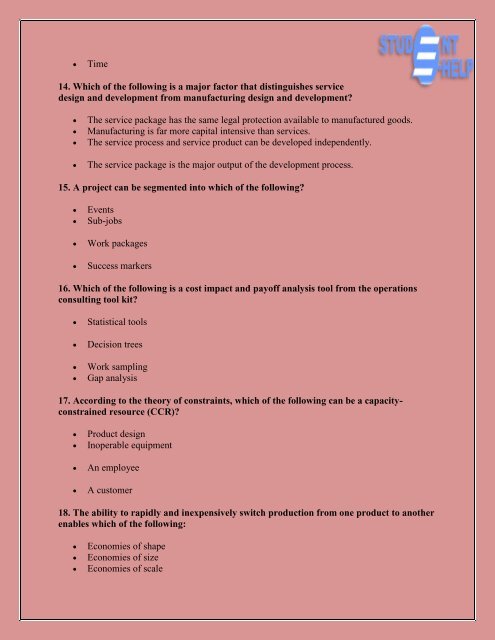OPS 571 Final Exam : OPS 571 Final Exam Answer | Studentehelp
If you have questions or can't find the tutorial then dont be upset here Studentehelp is there to solve your all questions regarding OPS 571 Final Exam, OPS 571 Final Exam, OPS 571 solved paper, UOP OPS 571 Final Exam for university of Phoenix student. http://www.studentehelp.com/university-of-phoenix/OPS-571.html
If you have questions or can't find the tutorial then dont be upset here Studentehelp is there to solve your all questions regarding OPS 571 Final Exam, OPS 571 Final Exam, OPS 571 solved paper, UOP OPS 571 Final Exam for university of Phoenix student.
http://www.studentehelp.com/university-of-phoenix/OPS-571.html
Create successful ePaper yourself
Turn your PDF publications into a flip-book with our unique Google optimized e-Paper software.
Time<br />
14. Which of the following is a major factor that distinguishes service<br />
design and development from manufacturing design and development?<br />
<br />
<br />
<br />
<br />
The service package has the same legal protection available to manufactured goods.<br />
Manufacturing is far more capital intensive than services.<br />
The service process and service product can be developed independently.<br />
The service package is the major output of the development process.<br />
15. A project can be segmented into which of the following?<br />
<br />
<br />
<br />
<br />
Events<br />
Sub-jobs<br />
Work packages<br />
Success markers<br />
16. Which of the following is a cost impact and payoff analysis tool from the operations<br />
consulting tool kit?<br />
<br />
<br />
<br />
<br />
Statistical tools<br />
Decision trees<br />
Work sampling<br />
Gap analysis<br />
17. According to the theory of constraints, which of the following can be a capacityconstrained<br />
resource (CCR)?<br />
<br />
<br />
<br />
<br />
Product design<br />
Inoperable equipment<br />
An employee<br />
A customer<br />
18. The ability to rapidly and inexpensively switch production from one product to another<br />
enables which of the following:<br />
<br />
<br />
<br />
Economies of shape<br />
Economies of size<br />
Economies of scale

















